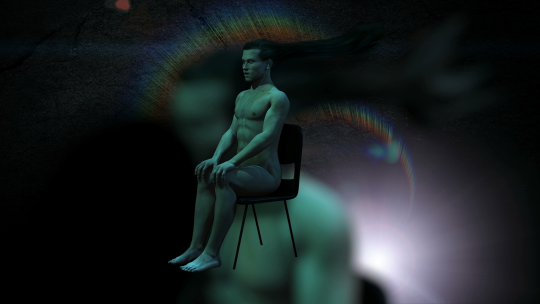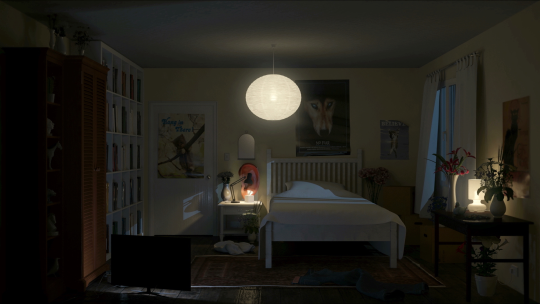 Still from Happy Birthday , Ed Atkins. 2014. Courtesy the artist.
Still from Happy Birthday , Ed Atkins. 2014. Courtesy the artist.
Artist Books / Artist’s Novels is an ongoing inquiry by Stephanie La Cava that looks at the intersection between visual art and literature. Each entry is a conversation with an artist or writer whose books defy genre expectations and exist outside of the traditional form.
Volume 1: Seth Price
Volume 2: Paul Chan
Volume 3: Alissa Bennett
Volume 4: Ed Atkins
Volume 5: Ed Ruscha
Stephanie LaCava in Conversation with Ed Atkins
At the end of the summer, FitzcarraldoEditions released the thick blue A Primer for Cadavers, a selection of British artist Ed Atkins’ writings from 2010 to 2016. While the Berlin-based writer is best known for his videos of computer generated figures spliced to vivid sound cuts, he is very much preoccupied with words.
Atkins sometimes provides texts to accompany his exhibitions. Many of these are included in the book, like “A Tumor (in English)”, once distributed alongside his 2011 Tate Britain show of the same name. Both writing and video often reference the abject or unseen body: a poetic meditation on tumors, for instance, or a CGI severed head bouncing down the stairs. It is perhaps best to let Atkins explain his writing, which seems eerily prophetic in relation to political events of late.
Take the following, from Hammering the Bars, as an example:
X: A Concern Troll.
Stage one is
X phantom limning in whichever web forums.
The masked troll seemingly devoted to the forum’s consensus: a proper apologist, as immoderate as the damnable moderator.
Stage two involves
X’s attempts to sway the group’s action or opinions—
all the while opining on their specific goals—only with professed concerns.
—Stephanie LaCava
STEPHANIE LACAVA: Can you speak to the recent world events and how you see them playing into your practice and point of view? In past conversations, you’ve mentioned The Invisibles, a comic book series with a drug that turns a word into the actual thing it represents, and you said how this is mirrored in the gaming of electronic profiles for impressions that lead to actual events or outcomes.
ED ATKINS: This is vast, right? I mean, to even scrape the surface feels like it requires a heft I’m not sure I can properly muster here… I’ll try a few thoughts. Firstly, there’s the thing I rehearse pretty much constantly in my videos and writing, namely poles of literality and figuration and how they are confused to political or ideological ends—and conversely how they might be used productively. Responsibly, even. So in a lot of my stuff this would directly relate to the disappearing of the material history of an object by the deliberate misapplication of literality for figuration—how calling something “The Cloud” maintains or conjures a fantasy for the express purpose of dematerializing server farms in a puff of pretty clunky figuration: A Cloud. This misuse is similarly likely in the other direction: the figurative for the literal. Like a Render Farm, for example. How it might be super productive to delve into the literal aspects of terms like that in order to better understand or make tangible the intangible world of digital representation, process, etc. The obfuscation in either direction is clearly about creating situations where the use of these things can occur with an impunity afforded by their apprehension as not really existing in our material world—rather in some digital no-place next to desire, fantasy, convenience and money. Obviously, the particulars of what I’m referring to are attached to the digital, but the effective cynical employment of figurative and literal language has been for ideological ends forever. It just seems like the particular ignorance and fantasy that orbits the ways in which we live with, via or in the digital, affords a new kind of virulence to these feints.
Our digital lives feel both more important than they actually are, and weirdly way less impactful—way less culpable than they certainly are. This, surely, is at least partly to do with our lack of understanding about the material conditions of the digital—how it’s constituted—and how it confuses temporal immediacy with material intimacy. Which is, I reckon, a version of the literal/figurative confusion. Certainly so much of what’s been happening—from the coining of various “post-truth” terms, to the rise of so-called populism—feels directly related to the ways in which life becomes increasingly disincorporated in genuinely disturbing ways (the conflict in Syria; bodies floating in the Med), and wholly incorporated in others—and I mean as in the forming of a corporation. But given the subject, you understand my underscoring of an etymological split in that incorporation. Rendering, farming, cutting, capturing, performing—this is a preeminent lexicon for computer generated imagery, but its also almost entirely rooted in material violence. That first slip of linguistic use was enough to eventually vanish the abattoir and the cadaver. Now, as applied to digital process, they are a part of another material evanescence, and on a massive scale.
I suppose this also relates to Grant Morrison’s Key 24 drug, as it appears in his Invisibles comic. That it makes whatever word written on a piece of paper become the real thing. There is perhaps no really reliable way in which one might be able to know what a word means any more. Or what its reality would be in application. This does feel deconstructionist, really—albeit crucially embodied, crucially corporealized in its attachments, its application, if it is to be saliently critical.
SLC: Much of the writing in the new book are from texts given for free in conjunction with exhibitions. Do you see them as explanatory texts or more as a way to prolong engagement with the viewer? Is there an aspect to them that functions based upon the ability to remove the “work” from the space?
EA: Totally. Though this was something more common earlier on. Nowadays the texts have pretty much entered the videos entire—or the videos have become texts. I always wanted things to be more holistic, less discrete, but I couldn’t quite work out how to do it. Or I didn’t quite have the courage to not use the writing as a bolstering or an apologetic thing. Inveigling the work a little further, I thought.
And certainly I wanted people to engage in the work in way that I think I also thought was asking too much. On my part. Giving people a free text—giving people a chunk of the work that they could have and engage with in their own time, felt both generous and demanding. People would hopefully get closer to the work, would allow it up against them in ways that an installation cannot sustain. The texts are certainly not explanatory. If anything, I think of them as extending the condition of the work as something resistant to the explanatory in general. I suppose they have directly engaged with the idea of something explanatory—particularly pieces like “An Introduction to the Work”—though they pointedly refuse to mean in pretty much any coherent way. I suppose I think of the videos and the writings as entirely equivalent to one another.

Still from Warm warm warm Spring Mouths, Ed Atkins. 2013. Courtesy the artist.
SLC: There is a history of artists playing with misspellings—Twombly, Broodthaers. Your device of choice seems to be metaphor. There are also instances of grammatical error. (““Um, wherever I will go, there I fucking will are am,”) and moments of word play—“digits” for example, as both numbers and figures, code and image—why fixate on metaphor?
EA: Regarding the visualizing of metaphor, the computer generated thing explains this best, I think. I mean, using CGI is to conjure imagery similarly to the way the written word does—from nothing but the imagination and some code, manifest only as image, as fantasy. That’s a forced and convenient rhyme, of course, but the sensation stands, I think.
CGI is capable of a level of realism that approaches proper signs—or at least they function like the real thing. However, their impossible plasticity and their infinite combinatory aspect means that I can make metaphors happen in an imagery that shouldn’t be able to do so. Cartoons have been doing this forever —and it’s the specific satire of caricature that is perhaps the best testament to that. But CGI introduces this crazy realism to the formula, meaning that the manifesting of a metaphor, visually, is super close to the metaphor becoming the real thing: the coming true of anything, really—with that always-already caveated “truth.”
A basic example would be at the end of my video “Ribbons,” where the guy is deflated. Literally: his head deflates. It’s dumb, but because of his empathy, his discomfiting approach, his address, etc, and how they’re predicated on his cleaving to reality, to realism, his deflating is a puncturing of that performance of reality for the sake of metaphoric affect. CGI makes the confusion possible. I guess this directly relates to what I was saying about the literal and the figurative above.
I’m not really aware of fixating on the metaphor. Or rather, isn’t “fixating on the metaphor” simply fixating on the structural? Fixating on the reappearance of language from whatever transparent, solely communicative application it might have been presumed to be able to perform.

Still from Safe Conduct, Ed Atkins. 2016. Courtesy the artist.
SLC: When you say “And the truth of metaphor being that it too much emphasizes a community of sameness.” Is this a nod to that recognition that occurs between a reader and a work (often of fiction) that endears them to the page?
EA: The “community of sameness” line is a quote, I think. Though from what, I can’t recall. I suppose I used it to mean the problems of determinism or determined coherence as regards understanding the Other is still very much present in as apparently poetic and potentially “free” a thing as metaphor. That it relies on a consensus as much any kind of literalism. More so, really, as what it occludes or negates is the thing that we have to rely on as our point of understanding. It’s certainly a way to hopefully engage the viewer, to rely on their understanding of what I mean (like the rhetorical appeal in conversation: “do you know what I mean?”) in order to move on, but also as way to create community between us—even if that community is perhaps dangerously a community of samenesses.
SLC: There’s aways talk of Gothic literature and Lacanian nods in reference to your work, wondering where Freud’s Uncanny comes into play? Do you have any special affinity in ETA Hoffmann’s Sandman story? (Also, what about Gabrielle Wittkop?)
EA: I guess there’s some pretty obvious, overt nods to Freud’s Uncanny and his reading of Hoffmann. The avatar, the heretical anima in the non-living. The not-quite human. These are a huge part of the affective aspects of my work. Gothic literature in general, I suppose. Horror, certainly—and genre more generally, of which I would say gothic horror is the preeminent example.
To engage with genre structurally is, I think, to engage with horror, insofar as genre’s movement is attached to presumed understanding—to go back to some instinctive, antediluvian sense of what we are and what we might presume our responses to be, surely horror most accurately describes what those presumed reactions are.
Right up to horror cinema, which is so terrifyingly legible, which- relies so heavily on its legibility. It’s something all my stuff flirts with, predominantly in order to undermine that very presumption, that formula. I can’t say I’ve every read any Wittkop—which I guess I should find shameful. Will rectify: have just placed an order for what is tantalizingly titled, The Necrophiliac. I would say that the Gothic might be an unavoidable style if you’re going to deal in corpses as regularly as I do. Fantasizing around the dead will render the gothic, no?
SLC: How much does Beckett come into play? I’m not sure I’ve ever read this confirmed, but the title Even Pricks—is that a nod too? What about the non-linear narratives of Alain Robbe Grillet (and his commentary on the collaborative nature of film)? John Barth? Does Mallarmé factor in at all—his name comes up time and time again among visual artists.
EA: Beckett, sure—how could it not?—though perhaps less explicitly or deliberately than I should admit. Even Pricks is certainly tonally a nod—though I’d like to think more broadly, to a kind of bathetic confusion Beckett would afford, but so would a lot of those later pomo americans, who certainly had a more immediate and steeling effect on me.
Barthelme is the big one, and so I suppose I kind of went backwards from there. Robbe Grillet, certainly—though I prefer the harder-core. Guyotat, Klossowski, Artaud. Mallarmé, yes, though not really worth going there, considering both your tired tone around his cropping up with artists, and the fact that he crops up with artists all the time!
SLC: And lastly, you’ve talked before about how there is not the primacy of say, drawing in writing, you are able to go back and edit. I’d love to hear more on this. You’ve also mentioned taking time to write a novel. Why continue to make visual art and not turn to literature full time?
EA: Do I have to choose? Probably. I’m almost entirely certain the whole threat of a novel thing is bollocks. I don’t think I mean it. At least in any conventional sense: I can scarcely write a sentence without getting mired in it, totally absorbed by it. Why a novel, then? I do know that I’d like more time to write solely. I continue to make visual art because I really enjoy it. And it’s a place (more than anything else, I increasingly think) that affords so much more possibility than any other. Why choose when I can keep smooshing shit together into tighter, weirder objects to be concurrently read, looked at, heard, felt.
I used to hardly edit the writing or the videos. Rather I’d generate what felt like fragments but which were actually whole: created that way. Sentences that feel like abbreviations of things, broken versions of things that once made sense, are actually broken from birth. Now I do edit a little more, though seldom for a reason that makes much sense outside of my own dim sensations. Edits that excise the sensible, mostly.
SLC: What are you reading now?
EA: I’ve recently read and enjoyed and felt and felt affinities of all kings with Linda Stupart’s first book of spells and misandry, Virus. Ian White’s collected writings, Here Is Information. Mobilize. Lots of Laura (Riding) Jackson, and I’d never read, amazingly, Edward Dorn or Geoffrey Hill until this year. Steven Zultanski’s Cop Kisser. Colette Thomas’ The Testament of the Dead Daughter. Theweleit’s Male Fantasies is sitting here begging to upheave shit. I dunno. Keston Sutherland’s circled back round—and Joe Luna is a constant. I did get a lot out of Seth Price’s Fuck Seth Price, though I’m not sure what I’ve ended up with. Sort of exhausted, I think. Jon Leon! Which was recommended by the anonymous lovelie(s) who write Contemporary Art Writing Daily, which is so so so good and renewed lots of things for me.

Still from Hisser, Ed Atkins. 2015. Courtesy the artist.
Read Part 1: A Conversation with Seth Price




